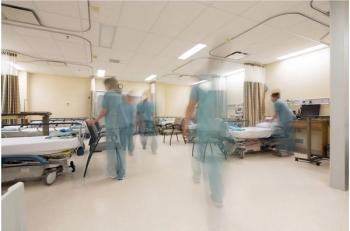
The Journal of Respiratory Diseases
- The Journal of Respiratory Diseases Vol 6 No 12
- Volume 6
- Issue 12
Case In Point: Odontogenic pneumomediastinum after routine dental extraction
We describe a rare case in which chest pain and subcutaneous emphysema developed while the patient was undergoing routine dental extractions under local anesthesia and inhaled nitrous oxide. The patient was found to have extensive pneumomediastinum on a CT scan of the chest. The patient received supportive care and 24-hour high-flow oxygen (100%) and was discharged the next day without any residual symptoms. At a 10-day follow-up visit, neck and chest radiographs revealed no further subcutaneous emphysema.
THE CASE
A 22-year-old woman presented to the emergency department (ED) with a chief complaint of chest pain, "fullness" in her chest, and a "crackling" feeling in her neck. An hour earlier, the patient had been undergoing routine dental extractions of her bilateral mandibular third molars when she began to have chest discomfort, neck pain, and a change in voice quality. The procedure consisted of a dental extraction with an air syringe and air-driven drill under local anesthesia and inhaled nitrous oxide.
The patient denied any shortness of breath. No other modifying factors or associated symptoms were present. There was no recent head or neck trauma.
Her medical history was positive for migraine cephalgia and negative for asthma. Her surgical history included a cholecystectomy. The patient was taking no medications at the time of presentation. She worked as a receptionist in a veterinarian's office. She was an active smoker (1 pack per day for the past 4 years).
The patient's blood pressure and heart rate were normal. Findings from her physical examination were most striking for palpable subcutaneous emphysema in the face, neck, and anterior chest. Breath sounds were clear and equal bilaterally. She was not receiving supplemental oxygen. Her oxygen saturation measured by pulse oximetry was 98%. There were no signs of respiratory distress.
The initial workup included a complete blood cell count with differential and measurement of blood urea nitrogen, serum creatinine, and random blood glucose levels; the results were all normal. Results of a qualitative serum pregnancy test were negative.
The patient underwent soft tissue radiography of the neck (Figure 1), chest radiography (Figure 2), and subsequent CT of the chest (Figure 3), which revealed extensive soft tissue emphysema in the neck and retropharyngeal areas. On the patient's CT scan, extrapleural air was noted in the medial aspect of the left upper pleural space (Figure 4). There was no evidence of a pneumopericardium.
The patient was admitted to the medical telemetry unit and was given 100% supplemental oxygen and orally administered narcotics for pain control. The next morning, the subcutaneous emphysema had nearly cleared. The patient felt fine and was discharged home. Ten days later, she was seen in the pulmonary office, and her neck and chest radiographs showed complete resolution of the subcutaneous emphysema.
DISCUSSION
Pneumomediastinum, the presence of free air within the mediastinum, is a usually benign and self-limited condition found in young men and parturient women. Frequently, it is found without an apparent cause. Pneumomediastinum, pneumothorax, and subcutaneous emphysema can occur after surgical procedures. Facial swelling is a common complication of dental intervention. The occurrence of subcutaneous emphysema, pneumothorax, and pneumomediastinum after dental procedures is rare.1
The first reported case of postsurgical subcutaneous emphysema was described by Turnbull2 in 1900. In that case, cervicofacial subcutaneous emphysema developed in a musician who blew a bugle shortly after having a tooth extraction.
The most consistent feature in the etiology of subcutaneous emphysema related to dental practice is the use of compressed air- powered instruments. Odontogenic pneumomediastinum has been reported following restorative dentistry,3 dental implant surgery, root canal surgery, and endodontic4 or periodontal treatment.5 More extensive surgical procedures involving the temporomandibular joint6 and correction of facial fractures7,8 have been known to cause more severe mediastinal emphysema.
Subcutaneous emphysema resulting from dental procedures is usually produced by a high-speed dental drill and air-and-water dental syringe.9,10 These air-driven drills have air directed toward the bur, which acts as a coolant; also, the air exhaust from the turbine is in the area of the surgical field. This makes it possible for the air or water under pressure to be driven in-to the disrupted intraoral barrier (dentoalveolar membrane or root canal).
Subcutaneous emphysema is the result of air being forced beneath the dermis. Air may dissect into deeper structures if a large amount of air is under pressure. The base of the first, second, and third molar roots communicate directly with the sublingual and submandibular spaces. These spaces communicate with the pterygomandibular, parapharyngeal, and retropharyngeal spaces. Air passes through the retropharyngeal space to the mediastinum and the pleural space. Air passing into the mediastinum and pleural space is most commonly associated with extraction of the third molar.11
Diagnosis
Although usually benign, subcutaneous emphysema can cause potentially life-threatening events, such as tension pneumomediastinum or tension pneumothorax. It usually presents as skin-colored swelling without inflammatory changes or edema. Patients are afebrile, without any local increase in warmth.
The results of blood chemistries are usually normal, and cultures typically yield negative results. In cases involving subcutaneous emphysema, soft tissue radiographs of the neck should be obtained for airway assessment and chest radiographs should be obtained to rule out mediastinal involvement. Anteroposterior chest radiographs usually show a radiolucent outline parallel to the margin of the heart. Lateral chest radiographs are often more helpful because they show retrosternal radiolucency with outlining of the aorta and mediastinal structures.
CT scans are superior to radiographs in assessing the topographic extension and accumulation of air. Air bubbles in the retropharyngeal space and carotid spaces are strongly indicative of air migration into mediastinum. CT scans can assist in distinguishing emphysema from necrotizing fasciitis caused by gas-forming organisms.
Treatment
The treatment of pneumomediastinum is symptomatic. Prevention of air emboli is the primary concern. Therapy includes sedatives to decrease excessive respiratory effort, stool softener to limit Valsalva maneuver, antitussive agents to suppress coughing, and nasal decongestants and antihistamines to suppress nose blowing. Administration of 100% oxygen may be considered to increase the tendency of resorption of nitrogen by reducing its surrounding partial pressure.
Most cases of subcutaneous emphysema begin to resolve after 2 to 3 days of supportive treatment, and residual swelling is usually minimal after 7 to 10 days of observation. Serial chest radiographs are obtained to follow the progress of air resorption and to guide treatment. Surgical decompression should not be routinely used, because it is likely to be ineffective and may even worsen or spread the emphysema. In severe cases in which there is airway compromise, endotracheal intubation--even tracheostomy--is indicated.
References:
REFERENCES
1. Chen SC, Lin FY, Chang KJ. Subcutaneous emphysema and pneumomediastinum after dental extraction.
Am J Emerg Med.
1999;17:678-680.
2. Turnbull A. A remarkable coincidence in dental surgery.
Br Med J.
1900;1:1131.
3. Andsberg V, Axell T. Mediastinal emphysema as a complication of dental treatment.
Odontol Res.
1972; 23:21-26.
4. Lloyd RE. Surgical emphysema as a complication in endodontics.
Br Dent J.
1975;138:393-394.
5. Snyder MB, Rosenberg ES. Subcutaneous emphysema during periodontal surgery: report of a case.
J Periodontol.
1977;48:790-791.
6. Chuong R, Boland TJ, Piper MA. Pneumomediastinum and subcutaneous emphysema associated with temporomandibular joint surgery.
Oral Surg Oral Med Oral Pathol.
1992;74: 2-6.
7. Piecuch JF, West RA. Spontaneous pneumomediastinum associated with orthognathic surgery. A case report.
Oral Surg Oral Med Oral Pathol.
1979; 48:506-508.
8. Carmichael F, Ward-Booth RP, Banks JM. Pneumomediastinum after facial trauma.
Oral Surg Oral Med Oral Pathol.
1988;66:540-542.
9. Buckley MJ, Turvey TA, Schumann SP, Grimson BS. Orbital emphysema causing vision loss after a dental extraction.
J Am Dent Assoc.
1990;120: 421-424.
10. Nahieli O, Neder A. Iatrogenic pneumomediastinum after endodontic therapy.
Oral Surg Oral Med Oral Pathol.
1991;71:618-619.
11. Cardo VA Jr, Mooney JW, Stratigos GT. Iatrogenic dental-air emphysema: report of a case.
J Am Dent Assoc.
1972;85:144-147.
Articles in this issue
about 19 years ago
Diagnostic Puzzlers: A patient with an "extra" pulmonary blood vesselabout 19 years ago
Clinical Consultation: Noninvasive ventilation for COPDabout 19 years ago
Questions Physicians Often Ask About Allergens That Trigger AsthmaNewsletter
Enhance your clinical practice with the Patient Care newsletter, offering the latest evidence-based guidelines, diagnostic insights, and treatment strategies for primary care physicians.




























































































































































































































































































































